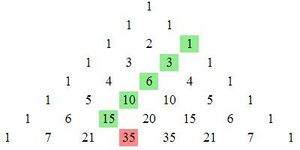Hockey-stick identity

In combinatorial mathematics, the hockey-stick identity,[1] Christmas stocking identity,[2] boomerang identity, Fermat's identity or Chu's Theorem,[3] states that if are integers, then
The name stems from the graphical representation of the identity on Pascal's triangle: when the addends represented in the summation and the sum itself are highlighted, the shape revealed is vaguely reminiscent of those objects (see hockey stick, Christmas stocking).
Formulations
Using sigma notation, the identity states
or equivalently, the mirror-image by the substitution :
Proofs
Generating function proof
Let . Then, by the partial sum formula for geometric series, we find that
- .
Further, by the binomial theorem, we also find that
.
Note that this means the coefficient of in is given by .
Thus, the coefficient of in the left hand side of our first equation can be obtained by summing over the coefficients of from each term, which gives
Similarly, we find that the coefficient of on the right hand side is given by the coefficient of in , which is
Therefore, we can compare the coefficients of on each side of the equation to find that
Inductive and algebraic proofs
The inductive and algebraic proofs both make use of Pascal's identity:
Inductive proof
This identity can be proven by mathematical induction on .
Base case Let ;
Inductive step Suppose, for some ,
Then
Algebraic proof
We use a telescoping argument to simplify the computation of the sum:
Combinatorial proofs
Proof 1
Imagine that we are distributing indistinguishable candies to distinguishable children. By a direct application of the stars and bars method, there are
ways to do this. Alternatively, we can first give candies to the oldest child so that we are essentially giving candies to kids and again, with stars and bars and double counting, we have
which simplifies to the desired result by taking and , and noticing that :
Proof 2
We can form a committee of size from a group of people in
ways. Now we hand out the numbers to of the people. We can then divide our committee-forming process into exhaustive and disjoint cases based on the committee member with the lowest number, . Note that there are only people without numbers, meaning we must choose at least one person with a number in order to form a committee of people. In general, in case , person is on the committee and persons are not on the committee. The rest of the committee can then be chosen in
ways. Now we can sum the values of these disjoint cases, and using double counting, we obtain
See also
- Pascal's identity
- Pascal's triangle
- Leibniz triangle
- Vandermonde's identity
- Faulhaber's formula, for sums of arbitrary polynomials.
References
- ↑ CH Jones (1996) Generalized Hockey Stick Identities and N-Dimensional Block Walking. Fibonacci Quarterly 34(3), 280-288.
- ↑ W., Weisstein, Eric. "Christmas Stocking Theorem" (in en). http://mathworld.wolfram.com/ChristmasStockingTheorem.html.
- ↑ Merris, Russell (2003). Combinatorics (2nd ed.). Hoboken, N.J.: Wiley-Interscience. pp. 45. ISBN 0-471-45849-X. OCLC 53121765. https://www.worldcat.org/oclc/53121765.
External links
 |

